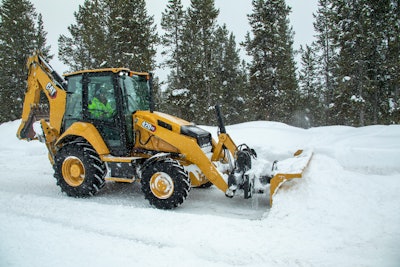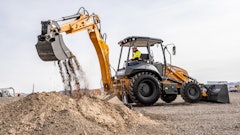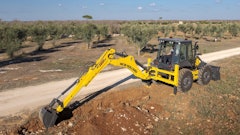
The versatility of the backhoe loader (also called a backhoe) has made it a valuable piece of equipment on a jobsite. According to James Gill, product manager, backhoes, with JCB, “One of the major selling points for the backhoe loader is the ability to perform multiple duties with one piece of equipment and one operator.”
While popular in the E.U. and the U.S., they currently are more widely used in the E.U. However, that trend is changing, and their versatility and benefits are resulting in their increased use in the U.S. and North America with the production of new models and added technologies.
Usage in the E.U.
 Backhoes can perform tasks often carried out by wheel loaders, CTLs, excavators and skid steers.CASE Construction Equipment
Backhoes can perform tasks often carried out by wheel loaders, CTLs, excavators and skid steers.CASE Construction Equipment
“In many European cities, where spaces tend to be tighter and more built up, a compact yet capable machine like the backhoe loader is in high demand [because] it reduces the crowding caused by multiple machines,” Gill said. “One of its standout features is the ability to drive it directly from one site to another, bypassing the hassle and cost of truck transport.”
Versatility is another reason for the backhoe’s popularity in Europe. “As the original two-in-one machine, the backhoe loader provides the versatility to perform backhoe and loader operations in a single package,” said George MacIntyre, CASE product manager for backhoe loaders.
Resurgence in North America
Until recently, usage of backhoes in North America had decreased or stalled. One reason for this is the use of different machines when the construction workforce was robust. According to Brian Hennings, backhoe product manager, John Deere, an excavator became a better option for some contractors.
 Backhoes' versatility is valued to complete many tasks with their front loader, excavator and accompanying attachments.John Deere
Backhoes' versatility is valued to complete many tasks with their front loader, excavator and accompanying attachments.John Deere
Another reason for the growth in backhoe use has been the construction workforce shortage.
“Over the last several years, a shortage of machine operators has become problematic for construction projects,” Gill said. “Therefore, backhoe loaders remain a popular choice for day-to-day operations on construction sites.”
David Young, backhoe loader product application specialist with Caterpillar agrees that the operator shortage may be a reason for the increase in backhoe loader use.
"We have seen the backhoe loader industry [tick up] this year," he said. "Product availability could be a factor (other non backhoe loader products), but I think it’s down to operator availability as well. A good operator and a BHL can do what two operators and two CCE machines can do."
When the workforce was less of an issue, the option of a mini excavator and CTL was an ideal solution on jobsites. However, these benefits are coupled with personnel challenges that backhoes do not have. When skilled operators are at a premium, having one operator using a backhoe minimizes the number of personnel needed on a jobsite.
“Using a mini excavator and compact track loader (CTL) combination requires contractors to have more skilled operators able to run the additional machines,” MacIntyre said.
Versatility
As many of the experts have mentioned, the versatility of backhoe loaders is a major benefit. They can perform many tasks, including those carried out by wheel loaders, CTLs, excavators and skid steers.
 Backhoes can do many tasks, such as digging trenches, moving loads and break concrete or frost with attachments.JCB North America
Backhoes can do many tasks, such as digging trenches, moving loads and break concrete or frost with attachments.JCB North America
According to MacIntyre, the performance and capabilities of backhoe loaders have dramatically increased during the past 20 years. Attachments for backhoes multiply the tasks that they can perform.
“When coupled with parallel lift in both directions, tool carriers are especially effective for avoiding material loss when operating attachments such as pallet forks … Numerous attachments give operators all the tools they need to improve speed, accuracy and productivity,” he said.
Hennings detailed other capabilities that make backhoes flexible for contractors on jobsites.
“Its front loader can load trucks, quickly backfill a trench, load and carry materials, or simply be a powered wheelbarrow. Its rear excavator can dig a trench, lift/crane/set objects in place and use attachments to break through frost or concrete.”
MacIntyre added more about the use of attachments with backhoes saying that they can “be used to do everything from laying pipe to digging trenches … [they] can even break up concrete or asphalt with a hydraulic hammer attachment.”
Other Benefits
According to Gill, backhoe loaders have many other benefits in addition to their versatility. These include:
- Maintenance. A backhoe loader performs multiple jobs, so only one machine needs upkeep.
- Transportation. As a road-friendly machine, the backhoe loader can move between sites and does not require special transportation.
- Operator requirements. A single operator can manage multiple tasks with one machine.
MacIntyre agrees with Gill’s idea of the backhoe’s road-friendly nature.
“Also, the slow top ground speeds of a mini excavator make it challenging to travel distances on or between jobsites, while the backhoe loader is well-suited to travel between jobsites, with speeds over 20 mph,” he said.
According to Young, other benefits include "strong breakout and heavy lift capability" along with "numerous options and configurations to ensure that the customer gets the machine they need."
New Technology & Capabilities
As backhoe loaders have benefits and versatility that make them a flexible choice for contractors, MacIntyre thinks that the technology and new capabilities of today’s backhoes are major benefit.
 A good operator and a backhoe can do what two operators and two compact construction equipment machines can do.Caterpillar
A good operator and a backhoe can do what two operators and two compact construction equipment machines can do.Caterpillar
One new technology that was previously only available on models in the E.U. is side-shift capability, which was on display at the Case booth during The Utility Expo.
“With a side-shift backhoe, operators can move the boom left or right instead of from a central pivot point," MacIntyre said. “This configuration provides more flexibility to move the boom parallel to walls or around obstacles while offering better visibility—[giving operators] easier access to dig trenches in hard-to-reach places.”
These models from Case also have vertical-style stabilizers that help decrease the backhoe’s footprint.
According to MacIntyre, “This feature makes [a backhoe] ideal for applications where an operator needs to work right up against a structure or take up less space, like roadside utility work.”
Other technology includes telematics and data management to improve operations, safety and maintenance of backhoe loaders.
 John Deere offers connectivity without subscriptions or annual renewals. The tech allows teams to analyze critical machine data, track use and review diagnostic alerts.John Deere
John Deere offers connectivity without subscriptions or annual renewals. The tech allows teams to analyze critical machine data, track use and review diagnostic alerts.John Deere
“The Operations Center also enables John Deere Connected Support, which uses data from thousands of connected machines to proactively address issues before they arise. Your dealer can also remotely monitor machine health, diagnose problems, and even update machine software without a trip to the jobsite,” Hennings said.
MacIntyre indicated that Case has put a focus on operator comfort with its new backhoe loader designs.
“We now offer a backhoe loader with a full, single-piece rear window that can be stowed overhead for improved line of sight and increased airflow. We also still have our traditional CASE three-piece rear windows, which allow operators to select which panel to open based on weather conditions or the need to communicate with workers on the ground,” he said.
When a Backhoe Is the Ideal Choice
When a contractor has fewer personnel to perform work and needs to minimize the costs of equipment transportation, a backhoe loader may be an efficient and ideal selection.
 A backhoe loader is well-suited to travel between jobsites and can reach speeds more than 20 mph.JCB North America
A backhoe loader is well-suited to travel between jobsites and can reach speeds more than 20 mph.JCB North America
Backhoes allow contractors to be more efficient because of their increased speed. According to Hennings, contractors should use a backhoe if multiple jobs are spaced out at distances too far for a slow-moving excavator to be effective.
MacIntyre agrees with the need for increased speed. It helps with efficiency when moving longer distances on jobsites and negates the time, labor and expense of loading a machine onto a trailer for transport.
“Backhoes are self-propelled at speeds of up to 20 miles per hour (mph) and can travel across jobsites and along roads, while excavators typically have a top speed of less than 5 mph and must be loaded onto a trailer to get from place to place, requiring extra time and labor,” he said.
Tomorrow’s Backhoe Loaders
Equipment manufacturers will continue to listen to the needs of contractors and operators as they improve and innovate backhoes. They will also need to look toward a zero-emission future with nontraditional power options. Case is working on an electric backhoe (the 580EV) with plans to launch it in the next couple years.
“The backhoe loader is well-suited for electrification because they typically vary use cycles between light- and heavy-duty work tasks,” MacIntyre said. “This provides a prime opportunity for contractors to convert wasted diesel engine hours into zero-consumption battery time, saving operating costs. Electric backhoes can be fully charged overnight, making them ideal for operations that return units to a home site at the end of the day.”






























